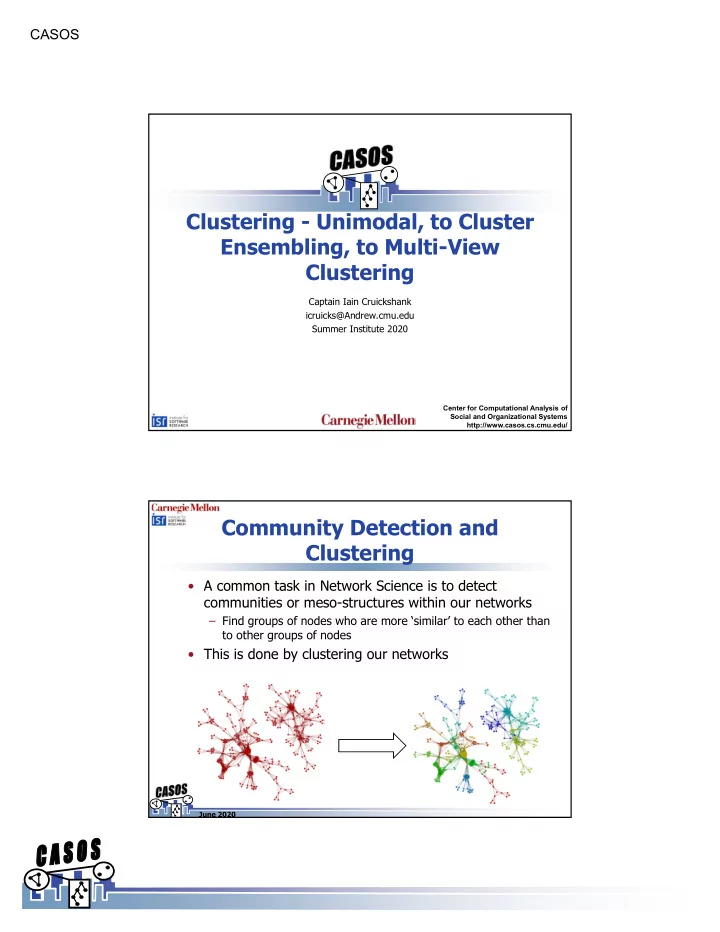

CASOS Clustering - Unimodal, to Cluster Ensembling, to Multi-View Clustering Captain Iain Cruickshank icruicks@Andrew.cmu.edu Summer Institute 2020 Center for Computational Analysis of Social and Organizational Systems http://www.casos.cs.cmu.edu/ Community Detection and Clustering • A common task in Network Science is to detect communities or meso-structures within our networks – Find groups of nodes who are more ‘similar’ to each other than to other groups of nodes • This is done by clustering our networks June 2020 1
CASOS There are many difficulties in clustering data • Clustering a data set often results in problems that are non-convex, NP-Hard, and has no (or many possible) labels • Many clustering algorithms are stochastic – The initialization matters • Clustering algorithms have many different types of losses that they are attempting to minimize – These loss function can capture different aspects of the data June 2020 Have you ever had this problem? You cluster a data set using something like Louvain or Louvain Network Clustering to get out cluster labels… … And then, later, when you run the same clustering technique on the same data set, you get a different set of labels then what you got the first time… June 2020 2
CASOS …Or these problems? • There are multiple ways of clustering your data set and you are not sure which is the right one • There could also be multiple user-set parameters for any given clustering algorithm and you are not sure how they should be set Leiden CONCOR Dense Subgraph June 2020 A Better Way to Cluster Our Data • What if we could combine all of the possible valid clusterings of our network to produce a robust and more accurate clustering of our network? – Able to take in any kind of clustering of our network – Able to ameliorate the effects of stochastic algorithms • We can! By Ensembling our Clusters June 2020 3
CASOS What is Ensembling ? • Ensembling is the combining of many different methods to get better results than any one method can produce • Ensemble methods are meta-algorithms that combine several machine learning techniques into one model • Very successful in supervised learning – Highly used in Competitive Data Science Competitions June 2020 Introducing Cluster Ensembling • Combine a collection of cluster labels into one labeling scheme for the data • Ensemble clustering should be robust and more representative of the cluster structure in the data than any given clustering June 2020 4
CASOS Cluster-based Similarity Partitioning Algorithm (CSPA) • One of the original cluster ensembling algorithms proposed by Strehl and Ghosh in 2002 in the seminal work for the field • Has seen many modifications over the years for things like link weighting, better graph clustering, and iterative refinement • We will just focus in on the basic algorithm for today June 2020 Cluster-based Similarity Partitioning Algorithm (CSPA) • Measure the similarity between every object being clustered by their ensemble clustering memberships, and then cluster this similarity matrix via suitable techniques Final Clusters • There are many proposed ways of calculating this similarity June 2020 5
CASOS Example Time! June 2020 Ensembling of Multiplex Networks • Cluster Ensembling can take in any clustering over the same objects • So, what if we have more than one network defined over the same objects? – E.g. multiple social media accounts, online and in-person contacts, many different types of interactions – Multiplex and multilayers networks June 2020 6
CASOS Ensembling of Multiplex Networks • We can even use cluster ensembling to combine multiple views of our data into one clustering ! • Can even be used to incorporate partial or incomplete views – You have labels for a population that were previously determined (i.e. user segments, previous clustering results, etc.) and want to combine those labels into one label – Some actors do not participate in certain actions (i.e. some Twitter users never re-tweet) June 2020 Time for Another Example! June 2020 7
CASOS Recap • Clustering is the means by which we find communities in our networks – Find those individuals which are more ‘similar’ to each other than to other groups of individuals • Cluster ensembling is a means of combining various clusterings over the same objects to get a better clustering of those objects • Cluster ensembling can be used for standard networks as well as multiplex networks and even partially complete networks • Cluster ensembling is an active area of research and has many useful techniques and strategies coming out June 2020 8
Recommend
More recommend